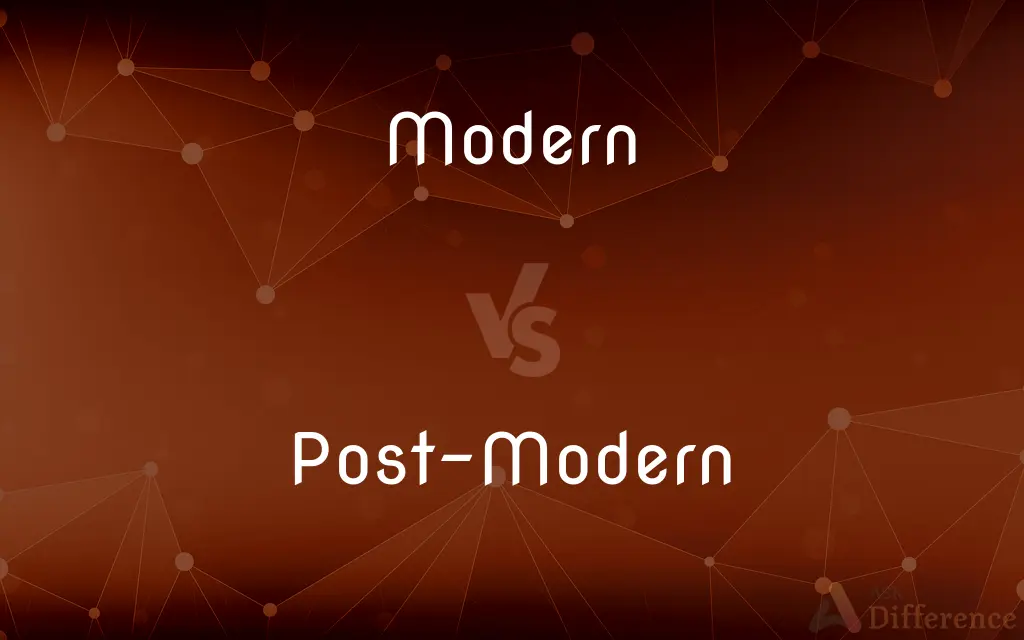Modern vs. Post-Modern — What's the Difference?
Edited by Tayyaba Rehman — By Urooj Arif — Published on March 4, 2024
Modern art focuses on the ideals of beauty and harmony, emphasizing clarity and simplicity. Post-modern art, however, embraces complexity and contradiction, questioning traditional aesthetics.

Difference Between Modern and Post-Modern
Table of Contents
ADVERTISEMENT
Key Differences
Modern art emerged in the late 19th and early 20th centuries, seeking to break away from traditional forms and techniques. It emphasizes innovation, the importance of materials and methods, and the idea of art for art's sake.
Post-modern art, arising in the mid-20th century, challenges the notions set by modern art by blurring the distinctions between high and low culture. It often incorporates a mix of different styles and mediums, reflecting skepticism towards universal truths and narratives.
Where modern art strives for originality and purity in artistic expression, post-modern art is characterized by its eclectic approach and the use of irony, parody, and pastiche. This reflects a cynical or playful attitude towards art's role in society.
Modern art is often seen as attempting to represent the absolute truths of humanity and the world, through abstraction, expressionism, and similar movements. Post-modern art, conversely, suggests that there are no absolute truths, embracing a more relativistic view of reality.
The dialogue between modern and post-modern art illustrates the shift from a focus on aesthetic beauty and formal innovation to a critique of cultural structures, embracing diversity and multiplicity in perspectives and interpretations.
ADVERTISEMENT
Comparison Chart
Time Period
Late 19th century - Mid 20th century
Mid 20th century - Present
Key Features
Innovation, simplicity, abstraction
Eclecticism, irony, diversity
Objectives
To explore beauty, form, and artistic purity
To question narratives, embrace paradox
Attitude
Serious, optimistic about progress
Skeptical, playful, challenges conventions
Representative Forms
Abstraction, minimalism, surrealism
Pastiche, parody, bricolage
Compare with Definitions
Modern
Modern art refers to artistic works produced during the period extending roughly from the 1860s to the 1970s.
Picasso's Cubist paintings revolutionized European painting and sculpture.
Post-Modern
It is characterized by a diverse range of styles and subjects, reflecting a skeptical or self-aware approach to art.
Cindy Sherman's photography questions the construction of identity.
Modern
It emphasizes the breaking away from established rules, traditional techniques, and classical subjects.
Jackson Pollock's drip paintings exemplify the freedom and innovation of modern art.
Post-Modern
Post-modern artists often use parody, bricolage, and intertextuality.
Roy Lichtenstein's pop art employs comic book aesthetics to comment on art and culture.
Modern
Modern art sought to capture the experience of life in the industrial age.
Marcel Duchamp's ready-mades challenged notions of what art could be.
Post-Modern
Post-modern art is a body of art movements that sought to contradict some aspects of modernism or have emerged or developed in its aftermath.
Jeff Koons' works incorporate kitsch to critique cultural hierarchies.
Modern
It often focuses on materials, techniques, and the process of creating art.
Frank Stella's minimalist works highlight the art-making process.
Post-Modern
It challenges the distinction between high culture and mass or popular culture, and between art and everyday life.
Andy Warhol's Campbell's Soup Cans blur the line between commercial and fine art.
Modern
Modern art movements include Cubism, Surrealism, Expressionism, and Futurism.
Salvador Dalí's surrealistic paintings explore the unconscious mind.
Post-Modern
Post-modernism embraces the idea that meaning is not universal and can be interpreted in multiple ways.
Robert Rauschenberg's combines mix painting and sculpture, challenging the viewer's perception of art.
Modern
Characteristic or expressive of recent times or the present; contemporary or up-to-date
A modern lifestyle.
A modern way of thinking.
Post-Modern
Alternative form of postmodern
Modern
One who has modern ideas, standards, or beliefs.
Modern
Of or pertaining to the present time, or time not long past; late; not ancient or remote in past time; of recent period; as, modern days, ages, or time; modern authors; modern fashions; modern taste; modern practice.
Modern
A contemporary person
Common Curiosities
What are some characteristics of modern art?
Characteristics include innovation, abstraction, and the emphasis on materials and methods.
When did modern art begin?
Modern art began in the late 19th century, around the 1860s.
What is the main difference between modern and post-modern art?
Modern art seeks purity and originality, while post-modern art embraces eclecticism and questions traditional values and hierarchies.
Can you give an example of a modern art movement?
Cubism is an example, known for its abstracted, geometric forms and fragmented subject matter.
How does modern art view the role of the artist?
Modern art views the artist as a visionary, seeking to explore and express new ideas and perspectives.
Can modern art be abstract?
Yes, abstraction is a key characteristic of many modern art movements.
When did post-modern art emerge?
Post-modern art emerged in the mid-20th century, following World War II.
What role does irony play in post-modern art?
Irony is used to challenge preconceptions, highlighting the artificiality or constructiveness of social and cultural norms.
How do post-modern artists view culture and society?
They often view culture and society with skepticism, using irony and parody to critique established norms.
What does post-modern art criticize about modernism?
It criticizes modernism's grand narratives and its distinctions between high and low culture.
Why is modern art considered important?
It represents a significant shift in the way art is perceived and created, emphasizing innovation and the expression of contemporary concerns.
What is a key feature of post-modern art?
A key feature is its questioning of the distinction between high and low culture.
What is a common technique in post-modern art?
Bricolage, or the use of diverse, often mundane materials, is common.
How does modern art approach the concept of beauty?
It often redefines beauty, focusing on abstract qualities and underlying forms.
Is post-modern art still relevant today?
Yes, post-modern art continues to influence contemporary art, reflecting ongoing debates about culture, identity, and the role of art in society.
Share Your Discovery

Previous Comparison
Turf vs. Artificial Grass
Next Comparison
White Collar Jobs vs. Blue Collar JobsAuthor Spotlight
Written by
Urooj ArifUrooj is a skilled content writer at Ask Difference, known for her exceptional ability to simplify complex topics into engaging and informative content. With a passion for research and a flair for clear, concise writing, she consistently delivers articles that resonate with our diverse audience.
Edited by
Tayyaba RehmanTayyaba Rehman is a distinguished writer, currently serving as a primary contributor to askdifference.com. As a researcher in semantics and etymology, Tayyaba's passion for the complexity of languages and their distinctions has found a perfect home on the platform. Tayyaba delves into the intricacies of language, distinguishing between commonly confused words and phrases, thereby providing clarity for readers worldwide.
















































